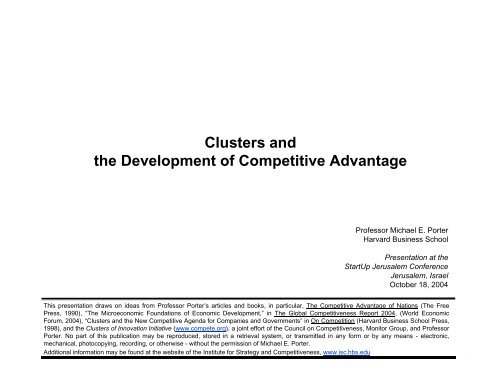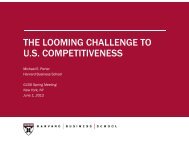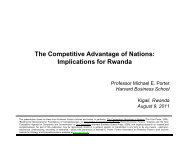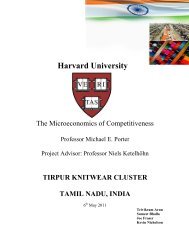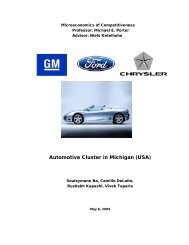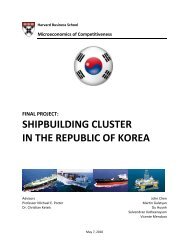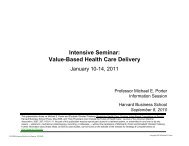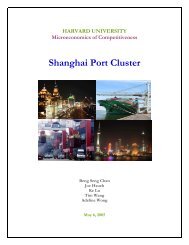Clusters and the Development of Competitive Advantage
Clusters and the Development of Competitive Advantage
Clusters and the Development of Competitive Advantage
You also want an ePaper? Increase the reach of your titles
YUMPU automatically turns print PDFs into web optimized ePapers that Google loves.
<strong>Clusters</strong> <strong>and</strong><br />
<strong>the</strong> <strong>Development</strong> <strong>of</strong> <strong>Competitive</strong> <strong>Advantage</strong><br />
Pr<strong>of</strong>essor Michael E. Porter<br />
Harvard Business School<br />
Presentation at <strong>the</strong><br />
StartUp Jerusalem Conference<br />
Jerusalem, Israel<br />
October 18, 2004<br />
This presentation draws on ideas from Pr<strong>of</strong>essor Porter’s articles <strong>and</strong> books, in particular, The <strong>Competitive</strong> <strong>Advantage</strong> <strong>of</strong> Nations (The Free<br />
Press, 1990), “The Microeconomic Foundations <strong>of</strong> Economic <strong>Development</strong>,” in The Global <strong>Competitive</strong>ness Report 2004, (World Economic<br />
Forum, 2004), “<strong>Clusters</strong> <strong>and</strong> <strong>the</strong> New <strong>Competitive</strong> Agenda for Companies <strong>and</strong> Governments” in On Competition (Harvard Business School Press,<br />
1998), <strong>and</strong> <strong>the</strong> <strong>Clusters</strong> <strong>of</strong> Innovation Initiative (www.compete.org), a joint effort <strong>of</strong> <strong>the</strong> Council on <strong>Competitive</strong>ness, Monitor Group, <strong>and</strong> Pr<strong>of</strong>essor<br />
Porter. No part <strong>of</strong> this publication may be reproduced, stored in a retrieval system, or transmitted in any form or by any means - electronic,<br />
mechanical, photocopying, recording, or o<strong>the</strong>rwise - without <strong>the</strong> permission <strong>of</strong> Michael E. Porter.<br />
Additional information may be found at <strong>the</strong> website <strong>of</strong> <strong>the</strong> Institute for Strategy <strong>and</strong> <strong>Competitive</strong>ness, www.isc.hbs.edu<br />
StartUp Jerusalem Cluster Theory 10-18-04 CK<br />
1<br />
Copyright © 2004 Pr<strong>of</strong>essor Michael E. Porter
What is <strong>Competitive</strong>ness?<br />
• <strong>Competitive</strong>ness is determined by <strong>the</strong> productivity with which a nation, region, or<br />
cluster uses its human, capital, <strong>and</strong> natural resources. Productivity sets a nation’s or<br />
region’s st<strong>and</strong>ard <strong>of</strong> living (wages, returns on capital, returns on natural resources)<br />
– Productivity depends both on <strong>the</strong> value <strong>of</strong> products <strong>and</strong> services (e.g.<br />
uniqueness, quality) as well as <strong>the</strong> efficiency with which <strong>the</strong>y are produced.<br />
– It is not what industries a nation or region competes in that matters for<br />
prosperity, but how firms compete in those industries<br />
– Productivity in a nation or region is a reflection <strong>of</strong> what both domestic <strong>and</strong> foreign<br />
firms choose to do in that location. The location <strong>of</strong> ownership is secondary for<br />
national prosperity.<br />
– The productivity <strong>of</strong> “local” industries is <strong>of</strong> fundamental importance to<br />
competitiveness, not just that <strong>of</strong> traded industries<br />
– Devaluation does not make a country more “competitive”<br />
• Nations or regions compete in <strong>of</strong>fering <strong>the</strong> most productive environment for<br />
business<br />
• The public <strong>and</strong> private sectors play different but interrelated roles in creating a<br />
productive economy<br />
StartUp Jerusalem Cluster Theory 10-18-04 CK<br />
2<br />
Copyright © 2004 Pr<strong>of</strong>essor Michael E. Porter
Real GDP per Capita 2002,<br />
PPP-adjusted, $-US (1990)<br />
25,000<br />
Prosperity<br />
Selected Countries<br />
20,000<br />
15,000<br />
Germany<br />
Israel<br />
France UK<br />
Italy<br />
Taiwan<br />
Portugal<br />
Finl<strong>and</strong><br />
New Zeal<strong>and</strong><br />
Spain<br />
Slovenia<br />
Greece<br />
South Korea<br />
Estonia<br />
10,000<br />
Czech Republic<br />
Malaysia<br />
Slovakia<br />
Latvia<br />
5,000<br />
Jordan<br />
0<br />
0% 1% 2% 3% 4% 5% 6% 7% 8%<br />
Growth <strong>of</strong> Real GDP per Capita (PPP-adjusted), CAGR, 1999-2002<br />
Source: Groningen Growth <strong>and</strong> <strong>Development</strong> Centre <strong>and</strong> The Conference Board (2004), authors’ calculations<br />
StartUp Jerusalem Cluster Theory 10-18-04 CK<br />
3<br />
Copyright © 2004 Pr<strong>of</strong>essor Michael E. Porter
Patenting Growth <strong>and</strong> Prosperity Growth<br />
Selected OECD Countries<br />
Compound annual<br />
growth rate <strong>of</strong> USregistered<br />
patents,<br />
1990 - 2003<br />
35%<br />
30%<br />
Singapore<br />
25%<br />
South Korea<br />
20%<br />
15%<br />
Taiwan<br />
R 2 = 0.60<br />
10%<br />
Denmark<br />
Israel<br />
Finl<strong>and</strong><br />
New Zeal<strong>and</strong><br />
Irel<strong>and</strong><br />
Sweden<br />
Norway<br />
5% Japan<br />
Australia<br />
US<br />
Italy<br />
Ne<strong>the</strong>rl<strong>and</strong>s<br />
Switzerl<strong>and</strong> France UK<br />
0%<br />
0% 1% 2% 3% 4% 5% 6% 7% 8%<br />
-5%<br />
Source: EIU (2004), US Patent <strong>and</strong> Trademark Office (2003)<br />
StartUp Jerusalem Cluster Theory 10-18-04 CK<br />
Compound annual growth rate <strong>of</strong> real GDP,<br />
1990-2003<br />
4<br />
Copyright © 2004 Pr<strong>of</strong>essor Michael E. Porter
Specialization <strong>of</strong> Regional Economies<br />
Select U.S. Geographic Areas<br />
Seattle-Bellevue-<br />
Everett, WA WA<br />
Aerospace Vehicles <strong>and</strong> <strong>and</strong><br />
Defense<br />
Fishing <strong>and</strong> <strong>and</strong> Fishing<br />
Products<br />
Analytical Instruments<br />
Denver, CO CO<br />
Chicago<br />
Lea<strong>the</strong>r <strong>and</strong> <strong>and</strong> Sporting Goods<br />
Communications Equipment<br />
Oil Oil <strong>and</strong> <strong>and</strong> Gas Gas<br />
Processed Food<br />
Aerospace Vehicles <strong>and</strong> <strong>and</strong> Defense<br />
Heavy Machinery<br />
Wichita, KS KS<br />
Pittsburgh, PA PA<br />
Aerospace Vehicles <strong>and</strong> <strong>and</strong><br />
Construction Materials<br />
Defense<br />
Metal Manufacturing<br />
Heavy Machinery<br />
Education <strong>and</strong> <strong>and</strong> Knowledge<br />
Oil Oil <strong>and</strong> <strong>and</strong> Gas Gas<br />
Creation<br />
Boston<br />
Analytical Instruments<br />
Education <strong>and</strong> <strong>and</strong> Knowledge Creation<br />
Communications Equipment<br />
San Francisco-<br />
Oakl<strong>and</strong>-San Jose<br />
Bay Area<br />
Communications<br />
Equipment<br />
Agricultural<br />
Products<br />
Information<br />
Technology<br />
Raleigh-Durham, NC NC<br />
Communications Equipment<br />
Information Technology<br />
Education <strong>and</strong> <strong>and</strong><br />
Knowledge Creation<br />
Los Angeles Area<br />
Apparel<br />
Building Fixtures,<br />
Equipment <strong>and</strong><br />
Services<br />
Entertainment<br />
San San Diego<br />
Lea<strong>the</strong>r <strong>and</strong> <strong>and</strong> Sporting Goods<br />
Power Generation<br />
Education <strong>and</strong> <strong>and</strong> Knowledge<br />
Creation<br />
Houston<br />
Heavy Construction Services<br />
Oil Oil <strong>and</strong> <strong>and</strong> Gas Gas<br />
Aerospace Vehicles <strong>and</strong> <strong>and</strong> Defense<br />
Atlanta, GA GA<br />
Construction Materials<br />
Transportation <strong>and</strong> <strong>and</strong> Logistics<br />
Business Services<br />
Note: <strong>Clusters</strong> listed are <strong>the</strong> three highest ranking clusters in terms <strong>of</strong> share <strong>of</strong> national employment<br />
Source: Cluster Mapping Project, Institute for Strategy <strong>and</strong> <strong>Competitive</strong>ness, Harvard Business School<br />
StartUp Jerusalem Cluster Theory 10-18-04 CK<br />
5<br />
Copyright © 2004 Pr<strong>of</strong>essor Michael E. Porter
Specialization <strong>of</strong> Regional Economies<br />
Commonwealth <strong>of</strong> Massachusetts<br />
12%<br />
Analytical Instruments<br />
Percentage<br />
<strong>of</strong> Share<br />
National<br />
Cluster<br />
Employment<br />
in 1999<br />
10%<br />
8%<br />
6%<br />
4%<br />
Education <strong>and</strong><br />
Knowledge Creation<br />
Information Technology<br />
Business Services<br />
Communications Equipment<br />
Jewelry <strong>and</strong> Precious Metals<br />
Medical Devices<br />
Financial Services<br />
Distribution Services<br />
Aerospace Engines<br />
(7.4, 89.9)<br />
Massachusetts’ Average<br />
Share = 2.68%<br />
2%<br />
Pharmaceuticals <strong>and</strong> Biotechnology<br />
(2.4, 103.6)<br />
Aerospace Vehicles <strong>and</strong><br />
Tobacco (0.9, 82.7)<br />
Defense (0.0, -97.7)<br />
0%<br />
-75 -25 25 75<br />
Percentage <strong>of</strong> Change, 1990–1999<br />
= 0–24,999 = 25,000–49,999 = 50,000–99,999 = 100,000-<br />
Note: Data points that fall outside <strong>the</strong> graph are placed on <strong>the</strong> borders with <strong>the</strong>ir values given in paren<strong>the</strong>ses (share, change)<br />
Source: Cluster Mapping Project, Institute for Strategy <strong>and</strong> <strong>Competitive</strong>ness, Harvard Business School<br />
StartUp Jerusalem Cluster Theory 10-18-04 CK<br />
6<br />
Copyright © 2004 Pr<strong>of</strong>essor Michael E. Porter
The Boston Life Sciences Cluster<br />
Health <strong>and</strong> Beauty<br />
Products<br />
Teaching <strong>and</strong> Specialized Hospitals<br />
Cluster Organizations<br />
MassMedic, MassBio, o<strong>the</strong>rs<br />
Surgical Instruments<br />
<strong>and</strong> Suppliers<br />
Medical Equipment<br />
Dental Instruments<br />
<strong>and</strong> Suppliers<br />
Biological<br />
Products<br />
Biopharma-<br />
ceutical<br />
Products<br />
Specialized Business<br />
Services<br />
Banking, Accounting, Legal<br />
Ophthalmic Goods<br />
Specialized Risk Capital<br />
VC Firms, Angel Networks<br />
Diagnostic Substances<br />
Containers<br />
Research Organizations<br />
Specialized Research<br />
Service Providers<br />
Laboratory, Clinical Testing<br />
Analytical Instruments<br />
Educational Institutions<br />
Harvard University, MIT, Tufts University,<br />
Boston University, UMass<br />
StartUp Jerusalem Cluster Theory 10-18-04 CK<br />
7<br />
Copyright © 2004 Pr<strong>of</strong>essor Michael E. Porter
Public Relations &<br />
Market Research<br />
Services<br />
The Cairns Tourism Cluster<br />
Travel agents<br />
Tour operators<br />
Local retail,<br />
health care, <strong>and</strong><br />
o<strong>the</strong>r services<br />
Food<br />
Suppliers<br />
Property<br />
Services<br />
Restaurants<br />
Attractions <strong>and</strong><br />
Activities<br />
e.g., <strong>the</strong>me parks,<br />
casinos, sports<br />
Local<br />
Transportation<br />
Souvenirs,<br />
Duty Free<br />
Maintenance<br />
Services<br />
Hotels<br />
Airlines,<br />
Cruise Ships<br />
Banks,<br />
Foreign<br />
Exchange<br />
Government agencies<br />
e.g. Australian Tourism Commission,<br />
Great Barrier Reef Authority<br />
Educational Institutions<br />
e.g. James Cook University,<br />
Cairns College <strong>of</strong> <strong>of</strong> TAFE<br />
Industry Groups<br />
e.g. Queensl<strong>and</strong> Tourism<br />
Industry Council<br />
Source: Research by HBS Student Team, 2003<br />
StartUp Jerusalem Cluster Theory 10-18-04 CK<br />
8<br />
Copyright © 2004 Pr<strong>of</strong>essor Michael E. Porter
<strong>Clusters</strong> <strong>and</strong> <strong>Competitive</strong>ness<br />
• <strong>Clusters</strong> Increase Productivity / Efficiency<br />
– Efficient access to specialized inputs, services, employees, information, institutions,<br />
<strong>and</strong> “public goods” (e.g. training programs)<br />
– Ease <strong>of</strong> coordination <strong>and</strong> transactions across firms<br />
– Rapid diffusion <strong>of</strong> best practices<br />
– Ongoing, visible performance comparisons <strong>and</strong> strong incentives to improve vs.<br />
local rivals<br />
• <strong>Clusters</strong> Stimulate <strong>and</strong> Enable Innovations<br />
– Enhanced ability to perceive innovation opportunities<br />
– Presence <strong>of</strong> multiple suppliers <strong>and</strong> institutions to assist in knowledge creation<br />
– Ease <strong>of</strong> experimentation given locally available resources<br />
• <strong>Clusters</strong> Facilitate Commercialization<br />
– Opportunities for new companies <strong>and</strong> new lines <strong>of</strong> established business are more<br />
apparent<br />
– Commercializing new products <strong>and</strong> starting new companies is easier because <strong>of</strong><br />
available skills, suppliers, etc.<br />
<strong>Clusters</strong> reflect <strong>the</strong> fundamental influence <strong>of</strong> externalities / linkages<br />
across firms <strong>and</strong> associated institutions in competition<br />
StartUp Jerusalem Cluster Theory 10-18-04 CK<br />
9<br />
Copyright © 2004 Pr<strong>of</strong>essor Michael E. Porter
Productivity, Innovation, <strong>and</strong> <strong>the</strong> Business Environment<br />
Factor<br />
(Input)<br />
Conditions<br />
• Presence <strong>of</strong> high quality,<br />
specialized inputs available<br />
to firms<br />
–Human resources<br />
–Capital resources<br />
–Physical infrastructure<br />
–Administrative infrastructure<br />
–Information infrastructure<br />
–Scientific <strong>and</strong> technological<br />
infrastructure<br />
–Natural resources<br />
Context for<br />
Firm<br />
Strategy<br />
<strong>and</strong> Rivalry<br />
• A local context <strong>and</strong> rules that<br />
encourage investment <strong>and</strong><br />
sustained upgrading<br />
–e.g., Intellectual property<br />
protection<br />
• Meritocratic incentive system<br />
across institutions<br />
• Open <strong>and</strong> vigorous competition<br />
among locally based rivals<br />
Related <strong>and</strong><br />
Supporting<br />
Industries<br />
• Access to capable, locally based suppliers<br />
<strong>and</strong> firms in related fields<br />
• Presence <strong>of</strong> clusters instead <strong>of</strong> isolated<br />
industries<br />
Dem<strong>and</strong><br />
Conditions<br />
• Sophisticated <strong>and</strong> dem<strong>and</strong>ing local<br />
customer(s)<br />
• Local customer needs that anticipate<br />
those elsewhere<br />
• Unusual local dem<strong>and</strong> in specialized<br />
segments that can be served<br />
nationally <strong>and</strong> globally<br />
• Successful economic development is a process <strong>of</strong> successive economic upgrading, in which<br />
<strong>the</strong> business environment in a nation evolves to support <strong>and</strong> encourage increasingly<br />
sophisticated ways <strong>of</strong> competing<br />
StartUp Jerusalem Cluster Theory 10-18-04 CK<br />
10<br />
Copyright © 2004 Pr<strong>of</strong>essor Michael E. Porter
Institutions for Collaboration<br />
Selected Massachusetts Organizations, Life Sciences<br />
Life Sciences Industry Associations<br />
• Massachusetts Biotechnology Council<br />
• Massachusetts Medical Device Industry<br />
Council<br />
• Massachusetts Hospital Association<br />
University Initiatives<br />
• Harvard Biomedical Community<br />
• MIT Enterprise Forum<br />
• Biotech Club at at Harvard Medical School<br />
• Technology Transfer <strong>of</strong>fices<br />
General Industry Associations<br />
• Associated Industries <strong>of</strong> <strong>of</strong> Massachusetts<br />
• Greater Boston Chamber <strong>of</strong> <strong>of</strong> Commerce<br />
• High Tech Council <strong>of</strong> <strong>of</strong> Massachusetts<br />
Informal networks<br />
• Company alumni groups<br />
• Venture capital community<br />
• University alumni groups<br />
Economic <strong>Development</strong> Initiatives<br />
Joint Research Initiatives<br />
• Massachusetts Technology Collaborative<br />
• Mass Biomedical Initiatives<br />
• Mass <strong>Development</strong><br />
• Massachusetts Alliance for Economic<br />
<strong>Development</strong><br />
• New Engl<strong>and</strong> Healthcare Institute<br />
• Whitehead Institute For Biomedical<br />
Research<br />
• Center for Integration <strong>of</strong> <strong>of</strong> Medicine <strong>and</strong><br />
Innovative Technology (CIMIT)<br />
StartUp Jerusalem Cluster Theory 10-18-04 CK<br />
11<br />
Copyright © 2004 Pr<strong>of</strong>essor Michael E. Porter
Patents by Organization<br />
Commonwealth <strong>of</strong> Massachusetts<br />
Organization Patents Issued from 1997 to 2001<br />
1 MASSACHUSETTS INSTITUTE OF TECHNOLOGY 518<br />
2 MASSACHUSETTS GENERAL HOSPITAL CORP 296<br />
3 EMC CORPORATION 269<br />
4 DIGITAL EQUIPMENT CORPORATION 261<br />
5 POLAROID CORPORATION 213<br />
6 ANALOG DEVICES, INC. 167<br />
7 MILLENNIUM PHARMACEUTICALS, INC. 165<br />
8 HARVARD UNIVERSITY 150<br />
9 COMPAQ COMPUTER CORPORATION, INC. 147<br />
10 SUN MICROSYSTEMS, INC. 143<br />
11 BOSTON SCIENTIFIC CORPORATION 135<br />
12 ACUSHNET COMPANY 130<br />
13 GENETICS INSTITUTE, INC. 127<br />
14 GILLETTE COMPANY 112<br />
15 BRIGHAM AND WOMEN'S HOSPITAL 107<br />
16 RAYTHEON COMPANY 101<br />
17 GENERAL ELECTRIC COMPANY 99<br />
18 HEWLETT-PACKARD COMPANY 96<br />
19 CHILDREN'S MEDICAL CENTER CORPORATION 93<br />
20 QUANTUM CORP. (CA) 93<br />
21 COGNEX CORPORATION 90<br />
22 DANA-FARBER CANCER INSTITUTE 90<br />
23 JOHNSON & JOHNSON PROFESSIONAL INC. 90<br />
24 BOSTON UNIVERSITY 84<br />
25 SEPRACOR INC. 84<br />
Note: Shading indicates universities, research institutions, <strong>and</strong> o<strong>the</strong>r government agencies<br />
Source: US Patent <strong>and</strong> Trademark Office (www.uspto.gov). Author’s analysis.<br />
StartUp Jerusalem Cluster Theory 10-18-04 CK<br />
12<br />
Copyright © 2004 Pr<strong>of</strong>essor Michael E. Porter
U.S. Patenting by Organizations Based in Israel<br />
Organization<br />
1997 1998 1999 2000 2001<br />
2002<br />
Patents Issued<br />
1997-2002<br />
YEDA RESEARCH AND DEVELOPMENT CO., LTD.<br />
14<br />
29<br />
35<br />
23<br />
23<br />
18<br />
142<br />
YISSUM RESEARCH DEVELOPMENT COMPANY OF THE HEBREW<br />
UNIVERSITY OF JERUSALEM<br />
19<br />
23<br />
28<br />
20<br />
29<br />
18<br />
137<br />
MOTOROLA, INC.<br />
19<br />
35<br />
32<br />
18<br />
22<br />
10<br />
136<br />
INTEL CORPORATION<br />
15<br />
31<br />
21<br />
22<br />
9<br />
16<br />
114<br />
INTERNATIONAL BUSINESS MACHINES CORPORATION<br />
12<br />
22<br />
12<br />
15<br />
19<br />
34<br />
114<br />
RAMOT UNIVERSITY AUTHORITY FOR APPLIED RESEARCH AND<br />
INDUSTRIAL DEVELOPMENT LIMIT<br />
8<br />
15<br />
12<br />
14<br />
14<br />
15<br />
78<br />
ISCAR LTD.<br />
10<br />
13<br />
10<br />
12<br />
11<br />
5<br />
61<br />
STATE OF ISRAEL, MINISTRY OF DEFENSE, RAFAEL-ARMAMENT<br />
DEVELOPMENT AUTHORITY<br />
17<br />
10<br />
7<br />
5<br />
9<br />
8<br />
56<br />
NATIONAL SEMICONDUCTOR CORPORATION<br />
18<br />
9<br />
8<br />
7<br />
4<br />
3<br />
49<br />
ORMAT INDUSTRIES, LTD.<br />
14<br />
7<br />
6<br />
4<br />
9<br />
5<br />
45<br />
3COM CORPORATION<br />
3<br />
1<br />
2<br />
5<br />
19<br />
18<br />
44<br />
BIOSENSE, INC.<br />
1<br />
4<br />
1<br />
5<br />
16<br />
15<br />
42<br />
SCI TEX CORPORATION LTD.<br />
12<br />
6<br />
13<br />
6<br />
3<br />
4<br />
40<br />
TOWER SEMICONDUCTOR LTD.<br />
1<br />
2<br />
2<br />
4<br />
18<br />
13<br />
38<br />
TEVA PHARMACEUTICAL INDUSTRIES, LTD.<br />
4<br />
5<br />
6<br />
1<br />
8<br />
11<br />
35<br />
APPLIED MATERIALS, INC.<br />
0<br />
1<br />
1<br />
3<br />
13<br />
17<br />
34<br />
MEDINOL LTD.<br />
2<br />
7<br />
5<br />
7<br />
4<br />
9<br />
34<br />
INDIGO N.V.<br />
2<br />
6<br />
9<br />
6<br />
4<br />
5<br />
32<br />
HADASIT MEDICAL RESEARCH SERVICES & DEVELOPMENT CO., LTD.<br />
0<br />
3<br />
7<br />
4<br />
9<br />
9<br />
32<br />
TECHNION RESEARCH AND DEVELOPMENT FOUNDATION, LTD.<br />
6<br />
4<br />
2<br />
2<br />
7<br />
7<br />
28<br />
StartUp Jerusalem Cluster Theory 10-18-04 CK<br />
Source: US Patent <strong>and</strong> Trademark Office<br />
13<br />
Copyright © 2004 Pr<strong>of</strong>essor Michael E. Porter
Shifting Responsibilities for Economic <strong>Development</strong><br />
Old Model<br />
New Model<br />
• Government drives economic<br />
development through policy<br />
decisions <strong>and</strong> incentives<br />
• Economic development is a<br />
collaborative process involving<br />
government at multiple levels,<br />
companies, teaching <strong>and</strong><br />
research institutions, <strong>and</strong><br />
institutions for collaboration<br />
StartUp Jerusalem Cluster Theory 10-18-04 CK<br />
14<br />
Copyright © 2004 Pr<strong>of</strong>essor Michael E. Porter
Cluster-Based Economic <strong>Development</strong><br />
Types <strong>of</strong> Activities<br />
• Upgrading <strong>of</strong> company strategy <strong>and</strong> operations<br />
– Developing market intelligence <strong>and</strong> operational benchmarks<br />
– Program to diffuse best practices (e.g. Quality certification)<br />
• Streng<strong>the</strong>ning <strong>of</strong> cooperation among companies <strong>and</strong> with universities on<br />
joint obstacles to competitiveness<br />
– More knowledge sharing across companies<br />
– Creation <strong>of</strong> cluster-specific initiatives <strong>and</strong> institutions<br />
– Government or external consultants as facilitators<br />
• Improvements <strong>of</strong> <strong>the</strong> cluster-specific business environment<br />
– Joint identification <strong>of</strong> barriers to productivity growth<br />
– Mounting joint public-private action initiatives to upgrade weaknesses<br />
• The appropriate mix <strong>of</strong> activities for a given cluster depends on <strong>the</strong> key<br />
weaknesses that hinder fur<strong>the</strong>r productivity growth<br />
StartUp Jerusalem Cluster Theory 10-18-04 CK<br />
15<br />
Copyright © 2004 Pr<strong>of</strong>essor Michael E. Porter
Public / Private Cooperation in Cluster Upgrading<br />
Minnesota’s Medical Device Cluster<br />
Context for<br />
Firm<br />
Strategy<br />
<strong>and</strong> Rivalry<br />
StartUp Jerusalem Cluster Theory 10-18-04 CK<br />
Factor<br />
(Input)<br />
Conditions<br />
• Joint development <strong>of</strong> vocationaltechnical<br />
college curricula with <strong>the</strong><br />
medical device industry<br />
• Minnesota Project Outreach exposes<br />
businesses to resources available at<br />
university <strong>and</strong> state government<br />
agencies<br />
• Active medical technology licensing<br />
through University <strong>of</strong> Minnesota<br />
• State-formed Greater Minnesota Corp.<br />
to finance applied research, invest in<br />
new products, <strong>and</strong> assist in technology<br />
transfer<br />
• Aggressive trade associations<br />
(Medical Alley Association, High<br />
Tech Council)<br />
• Effective global marketing <strong>of</strong> <strong>the</strong><br />
cluster <strong>and</strong> <strong>of</strong> Minnesota as <strong>the</strong><br />
“The Great State <strong>of</strong> Health”<br />
• Full-time “Health Care Industry<br />
Specialist” in <strong>the</strong> department <strong>of</strong><br />
Trade <strong>and</strong> Economic <strong>Development</strong><br />
Related <strong>and</strong><br />
Supporting<br />
Industries<br />
16<br />
Dem<strong>and</strong><br />
Conditions<br />
• State sanctioned<br />
reimbursement policies<br />
to enable easier adoption<br />
<strong>and</strong> reimbursement for<br />
innovative products<br />
Copyright © 2004 Pr<strong>of</strong>essor Michael E. Porter
Appropriate Roles <strong>of</strong> Government<br />
in Cluster <strong>Development</strong><br />
• A successful cluster policy builds on sound overall economic<br />
policies<br />
• Government should support <strong>the</strong> development <strong>of</strong> all clusters, not<br />
choose among <strong>the</strong>m<br />
• Government policy should reinforce established <strong>and</strong> emerging<br />
clusters ra<strong>the</strong>r than attempt to create entirely new ones<br />
• Government’s role in cluster initiatives is as facilitator <strong>and</strong><br />
participant. The most successful cluster initiatives are a publicprivate<br />
partnership<br />
StartUp Jerusalem Cluster Theory 10-18-04 CK<br />
17<br />
Copyright © 2004 Pr<strong>of</strong>essor Michael E. Porter
Role <strong>of</strong> <strong>the</strong> Private Sector in Cluster <strong>Development</strong><br />
• A company’s competitive advantage is partly <strong>the</strong> result <strong>of</strong> <strong>the</strong> local<br />
environment<br />
• Company membership in a cluster <strong>of</strong>fers collective benefits<br />
• Private investment in “public goods” is justified<br />
• Take an active role in upgrading <strong>the</strong> local infrastructure<br />
• Nurture local suppliers <strong>and</strong> attract new supplier investments<br />
• Work closely with local educational <strong>and</strong> research institutions to upgrade<br />
quality <strong>and</strong> create specialized programs addressing cluster needs<br />
• Provide government with information <strong>and</strong> substantive input on<br />
regulatory issues <strong>and</strong> constraints bearing on cluster development<br />
• Focus corporate philanthropy on enhancing <strong>the</strong> local business<br />
environment<br />
• An important role for trade associations<br />
– Greater influence<br />
– Cost sharing<br />
StartUp Jerusalem Cluster Theory 10-18-04 CK<br />
18<br />
Copyright © 2004 Pr<strong>of</strong>essor Michael E. Porter


